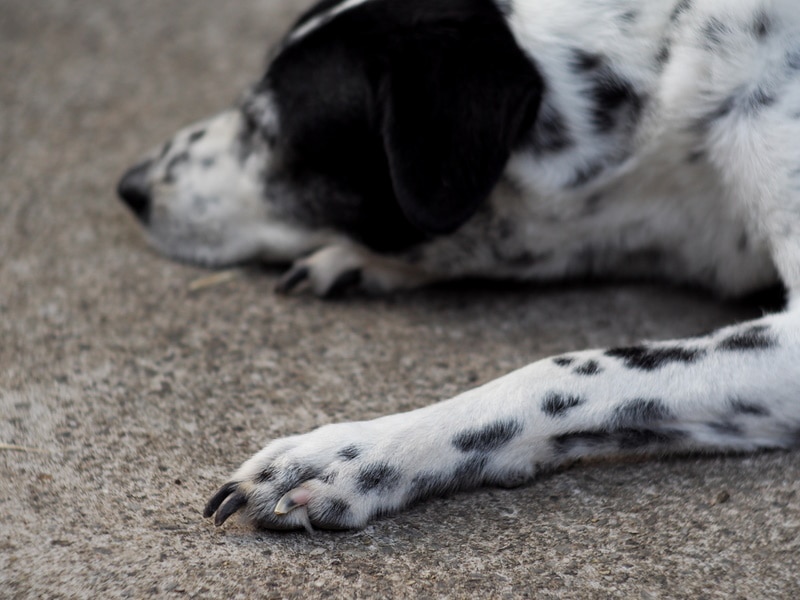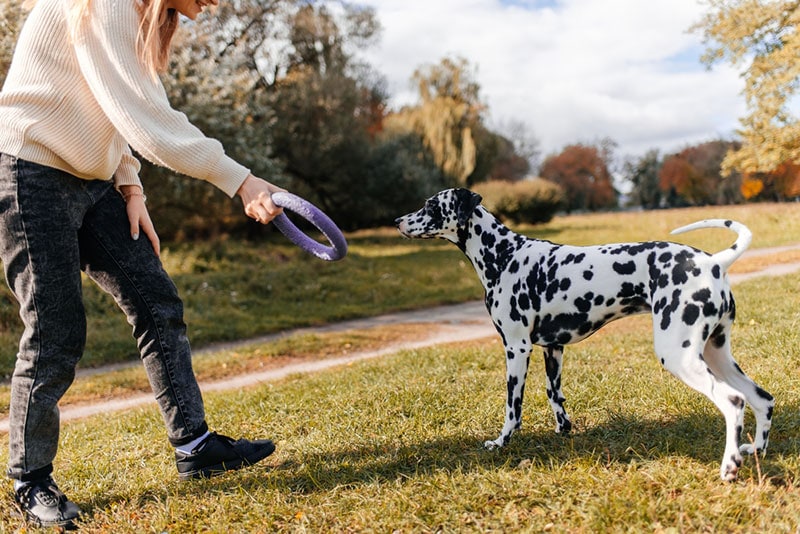Click to Skip Ahead
Dalmatians are well-known for their striking white and black appearance and their playful, loyal personalities. However, like many purebred dogs, Dalmatians suffer from specific health problems, including deafness. Up to 30% of Dalmatians worldwide are reported to be suffering from congenital deafness. Deafness, especially full bilateral deafness affecting both ears, can seriously impact a dog’s safety and quality of life.
Read on to learn more about this condition.
What Is Deafness in Dalmatians?
Deafness, or hearing loss, refers to the partial or complete loss of hearing ability in one or both ears. Deafness can be present at birth (considered congenital deafness) or can be acquired later in a dog’s life, depending on several factors and causes.
The type of deafness in Dalmatians discussed here is congenital deafness, which is inherited through genes and is present at birth. Congenital deafness has been reported in up to 30% of Dalmatians worldwide, with about 8% of all Dalmatians with bilateral deafness (both ears) and 22% with unilateral deafness (one ear).

What Are the Signs of Deafness in a Dalmatian?
Deafness in a dog is not always apparent to a casual observer, especially if it affects only one ear. It can be challenging for dog caretakers to identify deafness in their dogs.
- Lack of responsive to sounds, including loud noises or training/obedience commands
- Slow to rouse from sleep
- Unusual vocalizations or barking
- Difficulty locating when called from a distance
- Noticeably more startled at times
If you suspect your Dalmatian has hearing loss, it is important to have your dog evaluated properly by a veterinarian.
What Are the Causes of Deafness in Dalmatians?
The primary cause of deafness in Dalmatians is genetics. Recent research studies have shown that about 8% of Dalmatians have bilateral deafness, while around 22% are deaf in one ear. The increased risk of hearing loss in Dalmatians is due to a hereditary trait linked to the presence of a gene that is responsible for the Dalmatians’ famous white coat with black spots (known as piebald). While scientists have determined there is a linkage between the piebald gene and deafness, the presence of the gene does not always cause deafness in a dog.
The genetics at play with Dalmatians’ congenital deafness are known to be complex and are still under investigation. Because of the hereditary nature of deafness in Dalmatians, for years, experts have recommended against using deaf dogs for breeding. A recent study published in 2020 found that due to careful breeding decisions, the prevalence of congenital deafness in Dalmatians in the United Kingdom is declining.

How Do I Care for a Dalmatian with Deafness?
If you believe your Dalmatian is deaf, it is best to have your dog be properly evaluated and tested for hearing loss by a veterinarian. Aside from the clinical signs mentioned above, there is special testing that can be performed to diagnose hearing loss in dogs. From a very young age, puppies as young as 6 weeks old can have their hearing evaluated through the BAER (Brainstem Auditory Evoked Response) test. This test can detect any hearing loss in one or both ears by detecting electrical activity in the cochlea and auditory pathways in the brain. Not all veterinary clinics can do this test.
A good Dalmatian breeder will have their puppies checked as soon as possible before any sales to ensure hearing loss is properly evaluated and discussed with the new owners.
Once a dog is diagnosed with hearing loss, a caretaker can make special adjustments and actions to ensure their dog remains safe and can be properly trained and communicated with.
- Train and socialize: Early training and socialization with your deaf Dalmatian will be crucial for their livelihood. Learning to follow your visual commands and frequently checking in with you will be useful to keep them safe. Socializing with various people and animals will also be useful so they can continue to have safe and friendly interactions with those living in the world around them, even if they cannot hear.
- Use visual cues: Teaching your dog to learn your visual cues will be your special form of communication when your dog cannot hear your commands.
- Implement safety measures: Ensure your home, yard, and surrounding areas are familiar and safe for your dog, especially as they won’t be able to hear road traffic like a dog with normal hearing.
- Consider using a vibration collar: A gentle vibration collar can be a useful tool to gently grab your dog’s attention.
- Do not breed your deaf Dalmatian: To prevent the passing on of genetic traits associated with deafness, it is critical not to have your deaf dog reproduce. Your veterinarian can discuss with you options for sterilizing your dog to protect against unwanted pregnancies.
Frequently Asked Questions (FAQ)
How do I know a dog is a carrier or is likely to be affected by deafness?
Unfortunately, there is no way to test for a carrier dog (a dog that carries abnormal genes but is not affected by hearing loss). Any Dalmatian parent can still produce deaf puppies.
How does deafness affect a dog’s quality of life? Can deaf Dalmatians live a normal life?
Puppies who are born deaf are slow to learn and can be difficult to train. Deaf dogs can be trained through visual cues; however, it is not a complete substitute for verbal training and communication.
Since deaf dogs cannot hear road traffic and other noises around them, it is extremely unsafe for them to be roaming off-leash on or near a street. Because a deaf dog may not realize a person or animal is approaching them, it is important that others don’t sneak up on deaf dogs to avoid startling them.

Conclusion
Deafness in Dalmatians is a common hereditary health problem in the breed. Hearing loss in dogs poses significant training and safety hazards; however, with a patient caretaker and certain safety measures, a deaf dog can still thrive as an animal companion.
Featured Image Credit: Dora Zett, Shutterstock











